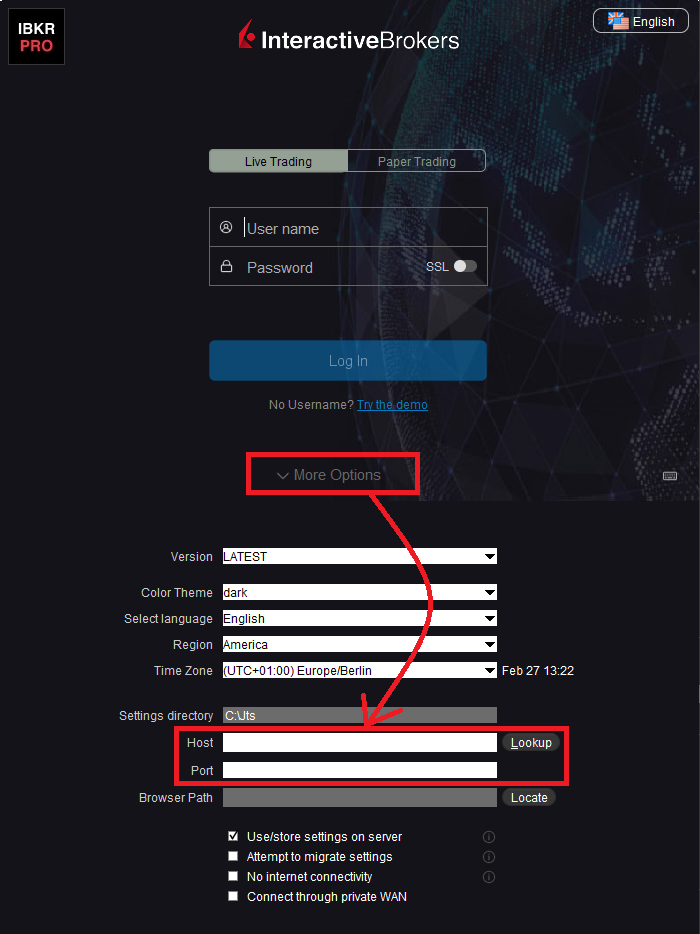携帯電話でIBKRからのテキストメッセージ(SMS)を受信することができません
携帯電話の番号がクライアント・ポータルで認証され次第、IBKRより直接お客様の携帯電話にテキストメッセージ(SMS)が送信されるようになります。こちらのページではメッセージの受信に問題がある場合の基本的な解決策をご説明します。
1. 二段階認証プロセス用にIBKRモバイル認証(IB Key) を有効化する
無線/通信会社の問題に左右されずに、IBKRより送信されるすべてのメッセージを安定して受信するために、スマートフォンでIBKRモバイル認証(IB Key)を有効化することをお勧めします。
IBKRモバイルアプリで利用可能な携帯電話でのIB Key認証は二段階認証プロセスとして機能します。このためIBKR口座にログインする際に、SMSで認証コードを受信する必要がなくなります。
現在、IBKRモバイルアプリは、アンドロイドまたはiOS のOSを搭載したスマートフォンに対応しています。インストール、有効化および管理に関する手順は以下のリンクよりご確認ください:
2. 携帯電話の再起動:
デバイスのスイッチを完全に切ってから再起動してください。通常はこの作業でテキストメッセージを受信できるようになります。
通信会社のカバー圏外(外国)でローミングが必要な場合などは、すべてのメッセージを受信できないことがあります。
3. ボイスコールバック機能の使用
スマートフォンを再起動してもログイン認証コードが配信されない場合には、代わりに「ボイス」機能を選択することもできます。この機能を選択すると自動音声によるコールバックでログイン認証コードを受信することができます。ボイスコールバック機能の使用方法は、IBKB 3396をご参照ください。
4. 通信会社がIBKRからのSMSをブロックしているかの確認
通信会社によってはIBKRからのテキストメッセージをスパムなどと認識し、自動的にブロックすることがあります。お住まいの地域に応じて、お使いの電話番号にSMSフィルターが適用されているかどうかの確認に、以下のサービスにお問合せください:
米国内:
- すべての通信会社: Federal Trade Commission Registry
- T-Mobile: メッセージブックの設定は、T-Mobileウェブサイトまたは、T-Mobileアプリで直接行うことができます
インド内:
- すべての通信会社: Telecom Regulatory Authority of India
中国内:
- 通信会社に直接電話して、IBKRからのメッセージをブロックしているかどうか確認してください
参考文献:
ログイン認証コードの受信にボイスコールバック機能を使用する方法
二段階ログイン認証プロセス用にSMSが有効化されている場合には、ログイン認証コードの受信にボイスコールバック機能を利用することができます。こちらのページではプラットフォームにログインする際にコールバック機能を使用する方法をステップごとにご説明します。
クライアント・ポータル
1. 「セキュリティーコードを受信されませんでしたか?」をクリックしてください
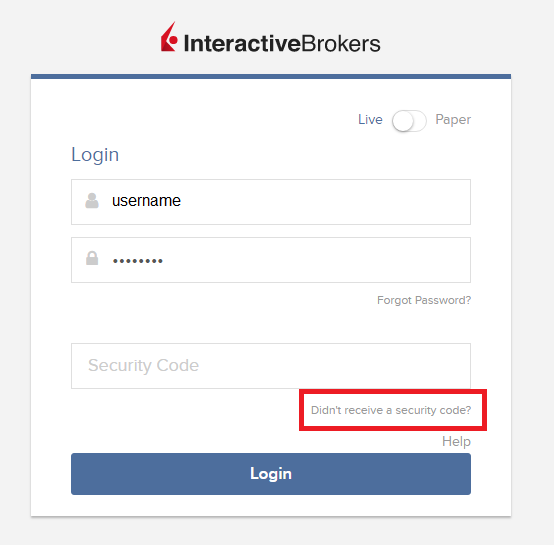
2. 二つあるオプションから「ボイス」を選択し、コールバックを待ってください。
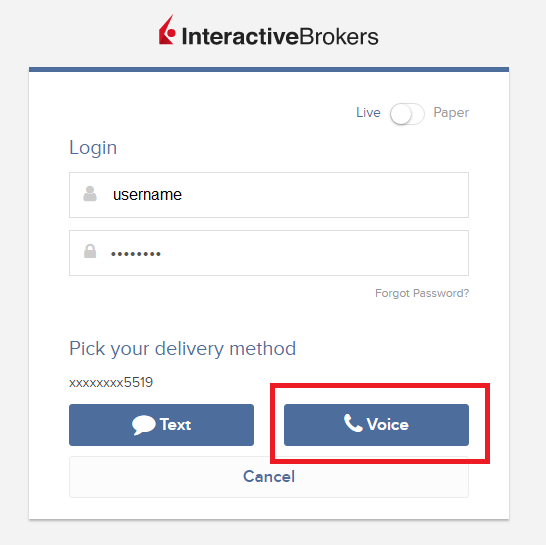
3. コールバックはボイスを選択してから通常1分内にかかってきます。認証コードを書き取るための準備をしてコールバックをお待ちください。
TWS
1. 「新しいセキュリティーコードをリクエストする」をクリックしてください
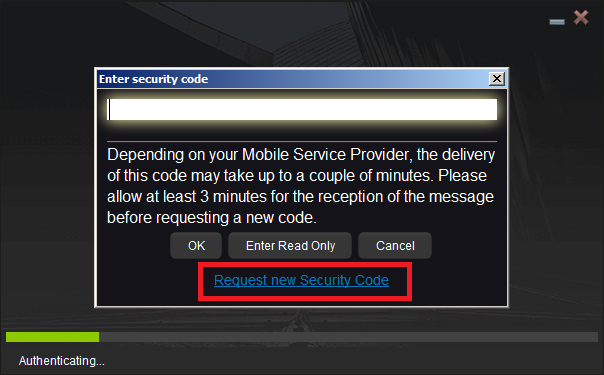
2. 二つあるオプションから「ボイス」を選択し、OKをクリックしてください。コールバックを待ってください。

3. コールバックはボイスを選択してから通常1分内にかかってきます。認証コードを書き取るための準備をしてコールバックをお待ちください。
注意: TWS用のボイスコールバックは最新バージョンとベータ版のみでご利用可能です。
iOS用IBKRモバイル
1. 「新しいコードをリクエストする」をクリックしてください
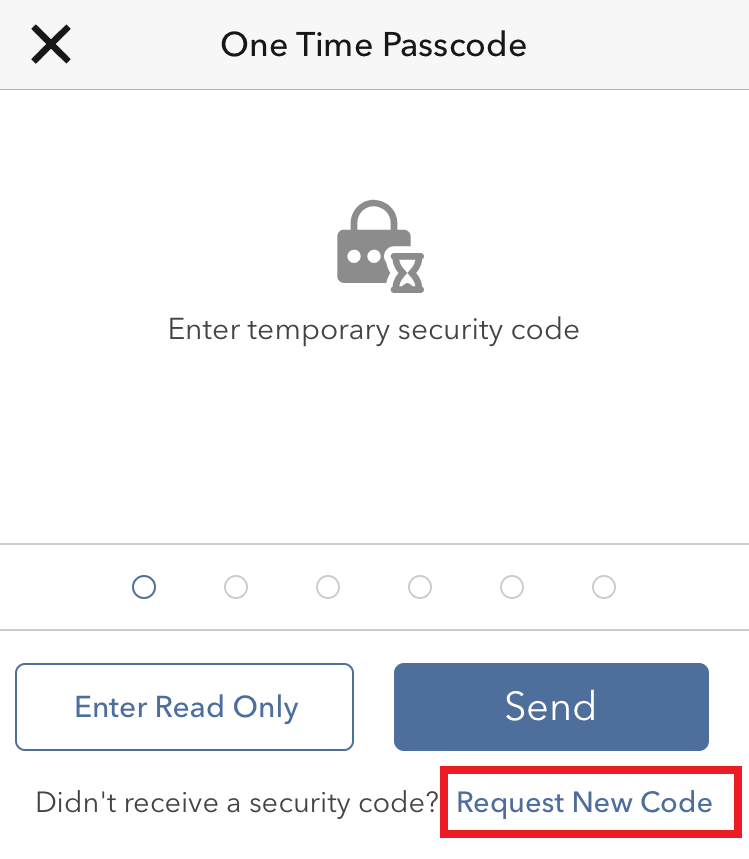
2. 二つあるオプションから「ボイス」を選択し、コールバックを待ってください。
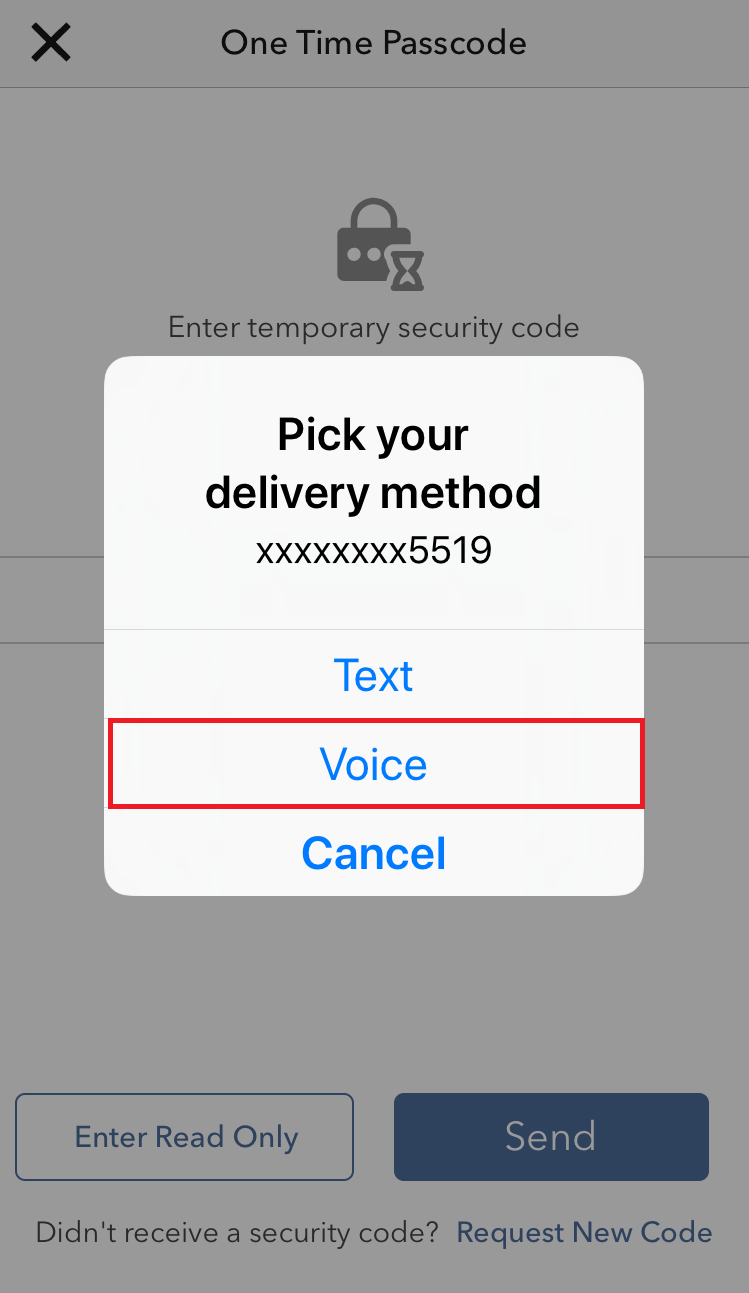
3. コールバックはボイスを選択してから通常1分内にかかってきます。認証コードを書き取るための準備をしてコールバックをお待ちください。
アンドロイド用IBKRモバイル
1. 「新しいセキュリティーコードをリクエストする」をクリックしてください

2. 二つあるオプションから「ボイス」を選択し、コールバックを待ってください。

3. コールバックはボイスを選択してから通常1分内にかかってきます。認証コードを書き取るための準備をしてコールバックをお待ちください。
参考文献:
セキュリティデバイスの共有方法
弊社ではひとつの口座や同じ管理の複数の口座に対し、複数のユーザー名を使用することができます。 複数のセキュリティデバイスの使用をご希望されないお客様は、ひとつのデバイスにまとめてすべてのユーザーに使用することができます。デバイスの共有にあたって必要となる事前条件と手順は以下をご参照ください。
事前に必要となる条件
実際のセキュリティデバイスの共有は以下の条件がすべてそろった場合のみ可能です:
a) 参加するユーザーが同じ事業体に属するか、異なる事業体に属していても本人確認のデータが同じであること(生年月日、国籍、法的居住国、身分証明書のタイプおよび番号、アメリカ市民または居住者は社会保障番号)。
b) 参加するユーザーが一時的なセキュリティデバイスを使用していないこと(テンポラリーコード、オンライン・セキュリティー・コード・カード)。
|
セキュリティレベル |
デバイス名 |
デバイスイメージ |
| 最高レベル | デジタル・セキュリティー・カード+ (DSC+) | 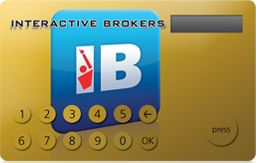 |
| 最低レベル | セキュリティー・コードカード(SLSカード) | 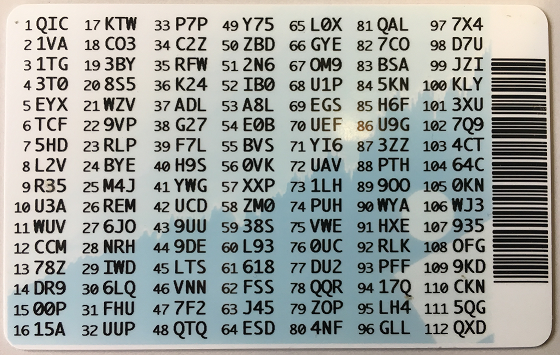 |
手順:
1. 複数のデバイスの中から保護レベルの一番高いものを選び、どのユーザーのものかを確認してください。このユーザーをデバイス所有者と呼びます。
2. クライアント・ポータルに、リクエストユーザーとして(デバイス所有者ではなく)ログインしてください
を選択してください
(1).png)
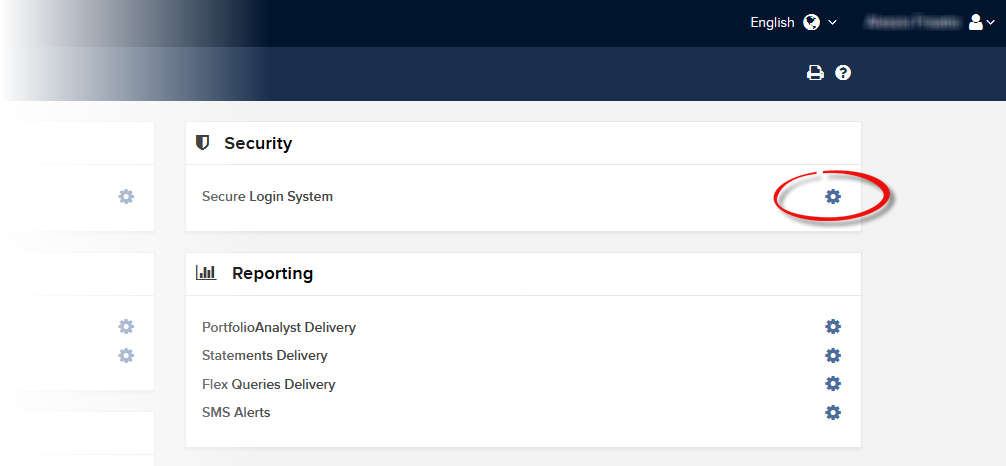
.png)

.png)
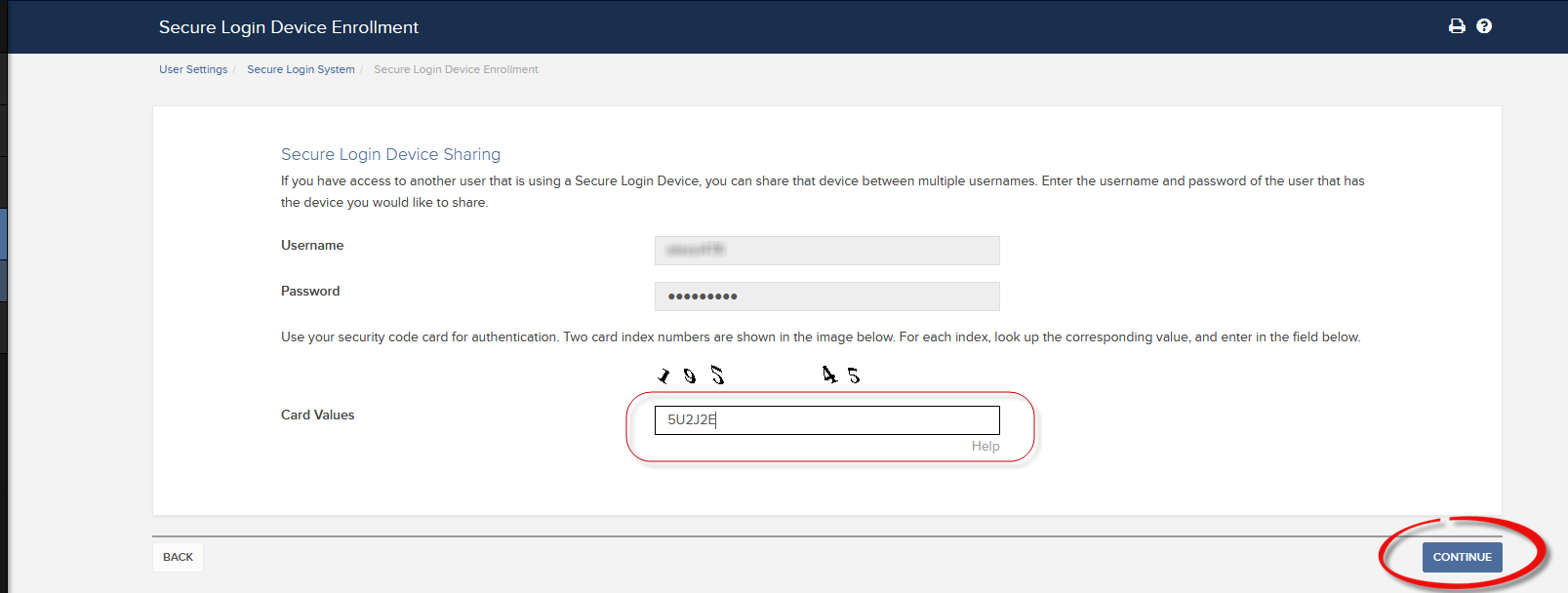

a. ほとんどの場合、共有化リクエストはすぐ自動的に処理された上で、承認ならびに有効化されます。コンプライアンス部門による承認が必要な場合には、これが完了するまでお手続き中の項目に表示されます。
c. 最も起こりやすいエラーメッセージとその原因は以下の様になります:
- デバイスのセキュリティレベルが低い: 共有化にセキュリティレベルの低いデバイスが選択された場合に出るエラーメッセージです。セキュリティレベルの最も高いものを再度確認して、こちらを共有してください。


参考文献:
- セキュア・ログインシステムの概要: KB1131またはibkr.com/sls
- マルチプル・ツーファクター認証システム(M2FS): KB2895
- 2人以上のユーザーで同じセキュア・ログイン・デバイスを使用する場合の手順: KB2481
- セキュア・ログイン・システムに戻る場合の手順: KB2545
- SLSのオプトアウトに関するセキュリティ上の注意点: KB1198
- セキュリティデバイスにかかる費用や請求KB1861
- クライアント・ポータル・ログイン関連エラーの問題解決手順: KB1132
- トレーディング・プラットホーム・ログイン関連エラーの問題解決手順: KB1133
How to generate a ".har" file
When troubleshooting a non-trivial website issue, it is sometimes necessary for our Client Services team to obtain additional information about your browser communication. You may be asked record and provide a .har file. This file contains additional information about the network requests that are sent and received by your browser. Your browser can generate such file by recording content, timeline and status of HTTP/HTTPS requests and responses while the issue occurs.
In this article we explain how to generate a .har file. Please click on the browser that you use in the list below:
To generate the HAR file for Google Chrome:
1. Open Google Chrome and go to the page where the issue is occurring.
2. Press CRTL +SHIFT + I on your keyboard. Alternatively, click on the Chrome menu icon (three vertical dots at the top-right of your browser window) and select More Tools > Developer Tools
3. The Developers Tools opens as a docked panel at the side or bottom of Chrome. Select the tab Network (Figure 1.)
Figure 1.
.png)
4. Look for a round Record button in the upper left corner of the Developer Tools toolbar and make sure it is red. If it is grey, click it once to start recording or just press CTRL+E (Figure 2.)
Figure 2.

5. Activate the checkbox Preserve log (Figure 3.)
Figure 3.
.png)
6. Click the Clear button to clear out any existing logs. The Clear button has a stop icon and is located on the right of the Record button (Figure 4.)
Figure 4.

7. Reproduce the issue you are experiencing while the network requests are being recorded.
8. Once you have reproduced the issue, right-click anywhere on the list of recorded network requests, select Save all as HAR with Content, and save the file to a location of your preference on your computer (e.g. on your Desktop).
9. From the IBKR Client Portal, go to the Message Center and create a new Web Ticket (or use an existing one when applicable)
10. Within the Web Ticket, attach the .har file previously generated. In case the IBKR Client Services has provided you with a reference ticker number or representative name, please add this information to the ticket body.
11. Submit the Web Ticket
To generate the HAR file for Firefox:
1. Open Firefox and go to the page where the issue is occurring
2. Press F12 on your keyboard. Alternatively click the Firefox menu icon (three horizontal parallel lines at the top-right of your browser window), then select Web Developer > Network
3. The Developers Network Tools opens as a docked panel at the side or bottom of Firefox. Select the tab Network (Figure 5.)
Figure 5.
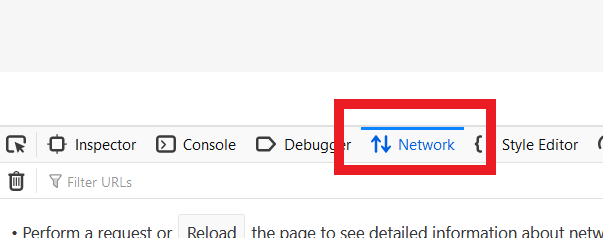
4. Activate the checkbox Persists logs (Figure 6.)
Figure 6.
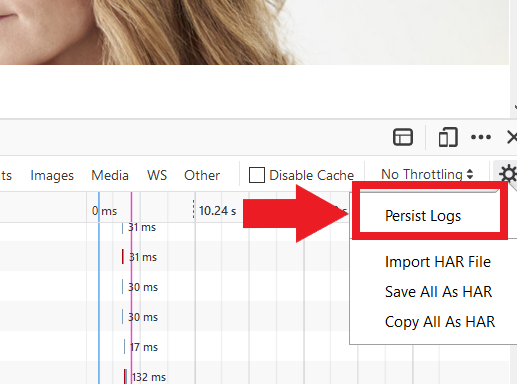
5. Reproduce the issue you are experiencing. The recording of the network request starts automatically.
6. Once you have reproduced the issue, right-click anywhere on the list of recorded requests and select Save All As HAR
7. Save the file to a location of your preference on your computer (e.g. on your Desktop)
8. From the IBKR Client Portal, go to the Message Center and create a Web Ticket (or use an existing one when applicable)
9. Within the Web Ticket, attach the .har file previously generated. In case the IBKR Client Services has provided you with a reference ticker number or representative name, please add this information to the ticket body
10. Submit the Web Ticket
To generate the HAR file for Microsoft Edge:
1. Open Edge and go to the page where the issue is occurring.
2. Press F12 on your keyboard. Alternatively click the Edge menu icon (three horizontal dots at the top-right of your browser window), then select More Tools > Developers Tools
3. Click the Network tab (Figure 10.)
Figure 10.
.png)
4. Reproduce the issue that you were experiencing before, while the network requests are being recorded.
5. Once done click the floppy disk icon (Export as HAR) or press CTRL+S (Figure 11.)
Figure 11.
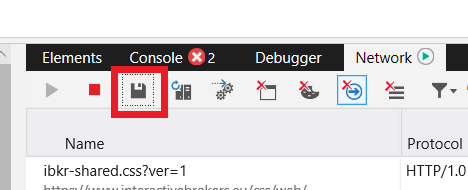
6. Provide a filename and a location of your preference on your computer (e.g. on the Desktop). Then click the Save button
7. From the IBKR Client Portal, go to the "Message Center" and create a Web Ticket (or use an existing one when applicable)
8. Within the Web Ticket, attach the .har file previously generated. In case the IBKR Client Services has provided you with a reference ticker number or representative name, please add this information to the ticket body.
9. Submit the Web Ticket
To generate the HAR file for Safari:
Note: Before generating the HAR file, make sure you can see the Develop menu in Safari. If you do not see this menu, click on the menu Safari, choose Preferences, go to the tab Advanced and activate the checkbox next to Show Develop menu in menu bar
1. Open the Develop menu and select Show Web Inspector or press CMD+ALT+I
2. Click the Network tab (Figure 12.)
Figure 12.

3. Activate the checkbox Preserve log (Figure 13.)
Figure 13.
.png)
4. Click on the icon Export (or press CMD+S), provide a filename and a location of your preference on your computer (e.g. on the Desktop) and save the .har file
5. From the IBKR Client Portal, go to the "Message Center" and create a Web Ticket (or use an existing one when applicable)
6. Within the Web Ticket, attach the web archive file previously generated. In case the IBKR Client Services has provided you with a reference ticker number or representative name, please add this information to the ticket body.
7. Submit the Web Ticket
How to use Voice callback for receiving login authentication codes
If you have SMS enabled as two-factor authentication method, you may use Voice callback to receive your login authentication codes. This article will provide you steps on how to select voice callback when logging in to our platforms.
Client Portal
1. Click on "Didn't receive a security code?"

2. From the two options, select "Voice" and wait for the callback.

3. After selecting Voice, you should receive the callback within a minute. Please wait for the callback and be ready to write down the code that will be provided over the callback.
TWS
1. Click on "Request new Security Code"

2. From the two options, select "Voice" and click on OK. Then wait for the callback.

3. After selecting Voice, you should receive the callback within a minute. Please wait for the callback and be ready to write down the code that will be provided over the callback.
Note: Voice callback for the TWS is only available in the LATEST and BETA version.
IBKR Mobile - iOS
1. Click on "Request New Code"

2. From the two options, select "Voice" and wait for the callback.

3. After selecting Voice, you should receive the callback within a minute. Please wait for the callback and be ready to write down the code that will be provided over the callback.
IBKR Mobile - Android
1. Click on "Request New Security Code"

2. From the two options, select "Voice" and wait for the callback.

3. After selecting Voice, you should receive the callback within a minute. Please wait for the callback and be ready to write down the code that will be provided over the callback.
References:
- How to login using SMS authentication
- Overview of Secure Login System
- Information and procedures related to Security Devices
- IBKR Mobile Authentication
IBKR Mobile Authentication (IB Key) Use Without Notifications
In case your smartphone is unable to receive IBKR Mobile notifications, you can still complete the login process using the IBKR Mobile Authentication (IB Key) Challenge/Response method, described on the following pages (according to your device operating system):
The same information applies to you if your phone has no Internet connectivity (you are in roaming, out of coverage, without an active mobile data plan, etc.)
If your smartphone is unable to receive IBKR Mobile notifications despite having Internet connectivity, we recommend you to perform the steps outlined in the IBKR Knowledge Base.
TWS / IB Gateway and their interaction with Proxy servers
Table of contents
Configuration instructions
- Can the TWS / IB Gateway operate through a Proxy server, and how?
- If I use a SOCKS Proxy server, do I need to configure the TWS / IB Gateway?
- If I use a SOCKS Proxy server, do I need to configure the client machines where TWS / IB Gateway runs?
- If I use a Web (HTTP) Proxy server, do I need to configure the TWS / IB Gateway?
- What alternatives do I have in case I cannot implement a proxy solution on my network?
Common issues
Technical Background
Configuration instructions
1. Can the TWS / IB Gateway operate through a Proxy?
Upon start-up and during the run-time, the TWS / IB Gateway must establish and maintain direct network connections to our gateways and market data servers1. Such connections are created from random local TCP ports (above 1024) and are directed to TCP ports 4000 and TCP 4001. Since those are not HTTP connections, they cannot be serviced by a Web (HTTP) Proxy. They can only be serviced by a SOCKS Proxy.
From within the TWS interface, you can access several external services, such as IBKR Client Portal, Statements, Contract details, Bond Search, etc. Those services, being web-based, can be accessed through a Web (HTTP) Proxy (see section 6 for details and configuration) or through a SOCKS Proxy (see sections 4. and 5. for details and configuration).
2. If I use a SOCKS Proxy server, do I need to configure the TWS / IB Gateway?
The TWS / IB Gateway does not contemplate an option for SOCKS proxy forwarding. Therefore, it does not have a place where an explicit SOCKS Proxy host/port can be configured. This does not mean that the TWS / IB Gateway cannot work with a Proxy. It simply means that the TWS / IB Gateway is unaware of the underlying SOCKS proxy setup (proxy-agnostic).
Important Note: While it is impossible for us to determine whether a Proxy is enabled on your network, we assure you that all IBKR platforms, including the TWS, do not impact nor influence your network configuration.
3. If I use a SOCKS Proxy server, do I need to configure the client machines where TWS / IB Gateway runs?
The connections started by the TWS / IB Gateway can be redirected to a SOCKS (Application) Proxy through a specific client machine setup. We mention some of them below. Please note that the final decision is yours and none of the below suggestions can be recommended by us as best adapted to your setup and requirements.
3a. Using a Proxy Client software installed on the client machine where TWS / IB Gateway is running
With this setup, the Proxy client will intercept the connections (not only HTTP but for other ports as well) initiated by the TWS / IB Gateway and redirect them to a SOCKS proxy server. The typical benefits of a transparent proxy include a standard enterprise configuration where all clients routed to the Internet will always be filtered and protected no matter what the end users do, or change, on their machines and the added benefit of reduction in typical user’s client-proxy configuration troubleshooting.
3b. Using a so-called Proxifier
This configuration is very similar to the one at point 5a with the only difference that the Proxifier software can be set to redirect to a Proxy all the requests started by a specific process (e.g., C:\Jts\tws.exe; C:\JTS\ibgateway\XYZ\ibgateway.exe), hence instating a process level packet forwarding instead of a port level forwarding. This setup allows handling environments where different proxy servers are used for different applications or where you would like to address a specific application requirement without modifying/disrupting the connectivity schema for other software installed. The advantage of this solution is minimal maintenance since the connectivity schema is bound to the process and not to the hosts/ports.
3c. Using specific network routing on a client machine
With this setup, you can modify the client machine standard network routes, adding new ones in order to forward packets with specific destinations (e.g., Order routing and Market Data servers1) to a different gateway.
This gateway will then be in charge of routing those requests to the destination hosts. This solution has as well the benefit of not modifying/disrupting the connectivity schema for other software installed but usually requires more maintenance on the gateway and on the client machine in case the IP of the destination servers are changed or in case new servers are added.
4. If I use a Web (HTTP) Proxy server, do I need to configure the TWS / IB Gateway?
If the Workstations on your local network access the Web content through a Web (HTTP) Proxy, you need to specify the Web Proxy IP Address and port. To do this, click More Options at the bottom of the TWS Login Screen, and enter your Proxy server details in the fields Host and Port (see Figure 1 below). The same fields are present in the IB Gateway Login Screen.
Figure 1.
The Web Proxy you set there will ONLY be used to fetch the web content accessible from within the TWS (e.g., Client Portal, Statements, Product Details, etc.)
5. What alternatives do I have in case I cannot implement a proxy solution on my network?
In this case, you might orient yourself towards a different type of access to the IBKR infrastructure, which includes a special connection type and a FIX/CTCI engine setup. This setup would, on the other hand, have different requirements in terms of commissions2.
Common Issues
6. What happens if the proxy configuration on your computer is wrong or outdated?
Occasionally, third-party software, even if already uninstalled, may leave behind a SOCKS proxy configuration on your computer. This may also happen if your computer has been infected with malware. In such cases, the proxy server, although configured, is non-existent or not accessible on the network. In such scenarios, the TWS will show an error message (e.g., No Internet Connectivity) and/or start the "Connection attempt #" loop upon login. The same will happen if the Proxy server exists, but has not been correctly configured on the client machines.
6a. How can I correct the proxy configuration if wrong?
When applicable, we recommend you always consult the IT / Networking team of your company first and ask for guidance.
If you are autonomously managing your network, please follow the instructions below according to the Operating System of your machine/s:
Windows
W.1 Press CTRL+S to open the Windows search
W.2 Type Proxy Settings and press Enter
W.3 If no Proxy is present on your network, make sure the switch "Use a proxy server" is deactivated (see Figure 2 below). If a Proxy server is active on your network, make sure the Address (or hostname) and Port are correctly defined.
Figure 2.
Mac
M.1 Click on the Apple icon at the top left corner of the screen and select System Preferences
M.2 Click on Network
M.3 Select the Network connection you are using to access the Internet (e.g. Wi-Fi) and click on it
M.4 Click on the Advanced button and then on the Proxies tab
5. If no proxy is present on your network, make sure all the checkboxes (SOCKS Proxy, Web Proxy, Secure Web Proxy) are deactivated (see Figure 3 below). If a Proxy is present on your network, ensure the Protocol, Address (or hostname) and Port are correct.
Figure 3.
7. You are using Public proxies and proxy chains to hide your presence or identity
There are public proxy and proxy chain services purposed to disguise or hide the identity and the activity of the subscriber or to bypass regional restrictions. One of the most famous services is the "Tor" network.
While those services may not necessarily be used for criminal purposes, they render subscriber traceability very difficult when not impossible. Since IBKR is obliged by the financial industry regulators to maintain records of trading activities and trade initiators, we do not allow our clients to reach our systems while using an anonymizing service. If you are using such a service, your TWS connection attempts will be automatically rejected by our gateways.
Technical Background
A proxy server usually acts as a gateway and as a barrier between your local network and the Internet. The proxy listens for outgoing connection requests from the internal workstation/s and forwards them to the desired target host or service on the Internet. When the target replies to such requests, the proxy routes the incoming responses back to the internal workstation/s that initiated the process.
Being the proxy, the only machine of your network actually accessing the Internet, it prevents the other machines and the internal segment of your network (LAN) from being accessible by external actors and hence from being exposed to threats and intrusion attempts.
Additionally, a proxy server can offer a variety of other services, such as web content caching and filtering.
9. Which types of Proxy servers are commonly used and where?
Proxy servers are commonly found within enterprise-grade networks. In the vast majority of cases, proxies are not used by individuals since private broadband connections are established through consumer-grade routers that already offer built-in proxy/firewall solutions. An exception is represented by public proxy or proxy chains discussed in detail in the section You are using Public proxies and proxy chains to hide your presence or identity
There are two main types of Proxy servers:
The HTTP (Hypertext Transfer Protocol) defines the rules and the standards for fetching Web content from a Web server and rendering such content on your Web Browser.
A Web Proxy handles only the routing of HTTP requests and HTTP responses. Those requests are transparently generated and sent by your browser whenever you access a Web page. Such requests are normally sent using specific ports (TCP 80 and TCP 443). Hence a Web Proxy usually listens for outgoing HTTP requests coming from your internal network (LAN) only on the TCP ports mentioned above.
SOCKS (Socket Secure) Proxies are designed to handle any type of traffic (not only HTTP/S traffic), generated by any protocol or program (including Trader Workstation).
Notes
1. More information about the servers accessed by the TWS is available in IBKB2816.
2. For an overview of the different special connection options and related requirements, please click here.
For an overview of the FIX infrastructure, please click here.
How to fix the "Cannot create ... file" error during TWS installation on MacOS
The filesystem permissions are controlled by your machines operating system. One of their functions is to secure your files, preventing unauthorized access or undesired modifications to the system and to your personal data.
Some software on your computer may modify or override the permissions assigned by the operating system. Under certain circumstances, this prevents the TWS installer from accessing the folder where the application core files have to be created (/users/youruser/home/Applications). In such cases, the TWS installation usually displays the error "Cannot create ... file. Shall I try again?"
Procedure:

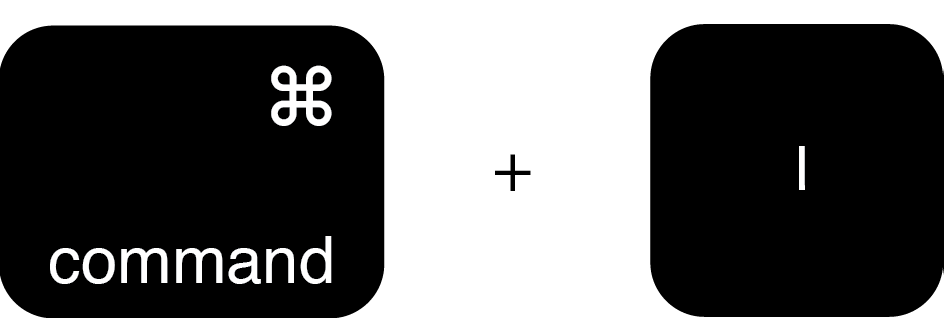


.png)

.png)
.png)
7. Once the installation has completed successfully, repeat the previous steps from 1. to 5. setting back the permissions of “everyone” to “Read Only” to revert your changes to the initial status
I am not receiving text messages (SMS) from IBKR on my mobile phone
Once your mobile phone number has been verified in the Client Portal, you should immediately be able to receive text messages (SMS) from IBKR directly to your mobile phone. This article will provide you with basic troubleshooting steps in case you are unable to receive such messages.
1. Activate the IBKR Mobile Authentication (IB Key) as 2-Factor security device
In order to be independent of wireless/phone carrier-related issues and have a steady delivery of all IBKR messages we recommend to activate the IBKR Mobile Authentication (IB Key) on your smartphone.
The smartphone authentication with IB Key provided by our IBKR Mobile app serves as a 2-Factor security device, thereby eliminating the need to receive authentication codes via SMS when logging in to your IBKR account.
Our IBKR Mobile app is currently supported on smartphones running either Android or iOS operating system. The installation, activation, and operating instructions can be found here:
2. Restart your phone:
Power your device down completely and turn it back on. Usually this should be sufficient for text messages to start coming through.
Please note that in some cases, such as roaming outside of your carrier's coverage (when abroad) you might not receive all messages.
3. Use Voice callback
If you do not receive your login authentication code after restarting your phone, you may select 'Voice' instead. You will then receive your login authentication code via an automated callback. Further instructions on how to use Voice callback can be found in IBKB 3396.
4. Check whether your phone carrier is blocking the SMS from IBKR
Some phone carriers automatically block IBKR text messages, as they are wrongly recognized as spam or undesirable content. According to your region, those are the services you can contact to check if a SMS filter is in place for your phone number:
In the US:
- All carriers: Federal Trade Commission Registry
- T-Mobile: Message Blocking settings are available on T-Mobile web site or directly on the T-Mobile app
In India:
- All carriers: Telecom Regulatory Authority of India
In China:
- Call your phone carrier directly to check whether they are blocking IBKR messages
References:
- How to login using SMS authentication
- Overview of Secure Login System
- Information and procedures related to Security Devices
- IBKR Mobile Authentication
IBのホストおよびポートに関する参照文献
SSLを使用する場合、TWSは弊社サーバーにポート4000と4001を介して接続します。その他のポートでは機能しません。プロキシ・サーバーをご利用の上でTWSを使用する際には、入ってくるポートおよび出て行くポートの両方が開いている透明な状態にあることが必要です。
下記は弊社のTWSサービスをご利用いただく際に使用可能なゲートウェイすべておよびそのホストになります。これらのホストのアクセスを許可してください。
お客様の接続に必要な設定の確認や、正しく設定されているかの確認はIBKRテスト専用ページより簡単にできます。このページではメインの取引とマーケットデータのサーバーにお客様のネットワークが接続されているかテストをします。「成功」の返答が出た場合には、それ以上何も必要ありません。「失敗」が出た場合には、お客様のネットワーク設定に新規ホストの許可を追加するか、変更の再確認をお奨め致します。
注意: お客様のネットワークがブラウザーのプロキシを使用している場合、テストページが正確でない表示をする可能性があります。こういった場合やネットワーク設定に確信がない場合にはネットワーク管理者にご連絡いただき、下記にリストされるホストのピンおよびテルネット・テストを行って、接続条件のコンプライアンスに問題がないことをご確認ください。
仕様:
|
クライアント・ポータルおよびウェブサイト |
||||
|
地域/商品 |
サーバー(ホスト) |
ポート1 |
||
|
IBKRウェブサイト – アメリカ |
443 |
|||
|
IBKRウェブサイト – カナダ |
443 |
|||
|
IBKRウェブサイト – イギリス |
443 |
|||
|
IBKRウェブサイト – インド2 |
443 |
|||
|
IBKRウェブサイト – 日本2 |
443 |
|||
|
IBKRウェブサイト – 香港2 |
www.interactivebrokers.com.hk | 443 | ||
|
IBKRウェブサイト – 中国2 |
www.ibkr.com.cn | 443 | ||
|
IBKRウェブサイト – オーストラリア |
www.interactivebrokers.com.au | 443 | ||
|
クライアント・ポータル – 東 |
443 |
|||
|
クライアント・ポータル – 中央 |
443 |
|||
1: 標準のコミュニケーション: TCP Port 80 | SSL コミュニケーション: TCP Port 443.
2: このIBサーバーではping要求をサポートしていません。
重要: インターネットへのアクセスを負荷分散させるシステムを使用する企業ネットワーク経由でクライアント・ポータルにアクセスされる場合、ログイン中やログイン後に期限切れ/無効なセッション、またはウェブコンテンツ不足などのエラーメッセージが出ることがあります。負荷分散を行うシステムはネットワークの負担を均等に保つため、2つ以上のネットワークインターフェースを通して発信接続を循環させています。このメカニズムが使用される場合、お客様のHTTPリクエストは異なるIPアドレスを通して弊社のシステムに届くことになり、クライアント・ポータルのセッションの無効化につながることがあります。こういった場合にはネットワーク管理者やITグループにご連絡いただき、ご利用の機器やデバイスが負荷分散機能をバイパスできる設定をリクエストしていただきますと、クライアント・ポータルのセッションが無効化されなくなります。
|
デスクトップTWS |
|||
|
地域/ツール |
主要/バックアップ |
サーバー(ホスト) |
ポート |
|
|
主要 |
|
|
|
バックアップ |
|||
|
|
主要 |
|
|
|
バックアップ |
|||
|
|
主要 |
|
|
|
バックアップ |
|||
|
TWSアジア |
主要 |
4000 / 4001 |
|
|
バックアップ |
|||
|
TWSアジア – 中国3 |
主要 |
4000 / 4001 |
|
|
バックアップ |
mcgw1_hb1.ibllc.com.cn | ||
| TWS自動アップデート | 主要 | 443 | |
|
リスク・ナビゲーター |
主要 |
443 |
|
|
TWSクラウド設定 |
主要 |
443 |
|
|
IB CAM |
主要 |
4000 / 4001 |
|
|
診断レポート |
主要 |
443 |
|
3:香港のサーバーに割当される口座をお持ちのお客様用のゲートウェイですが、物理的な接続は中国本土からとなります。


